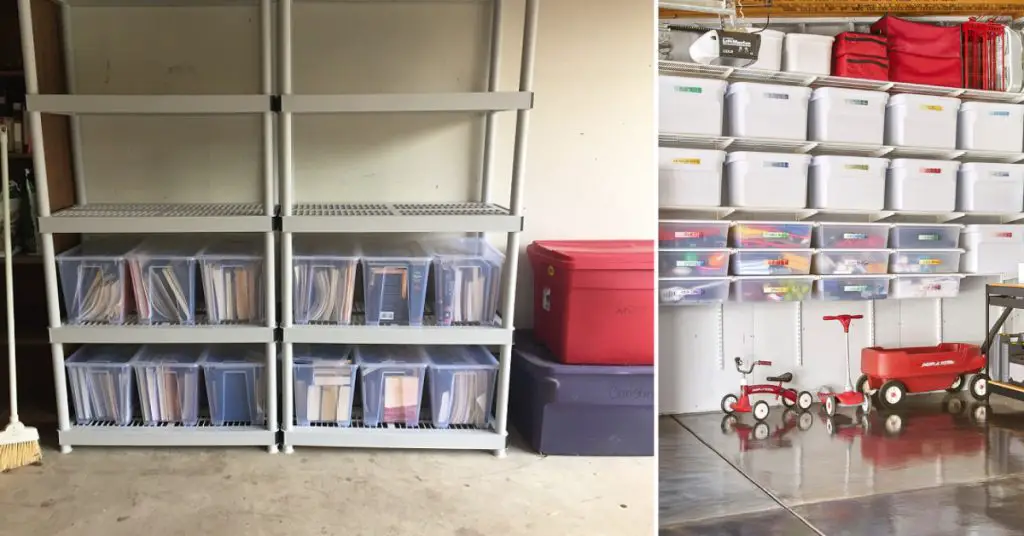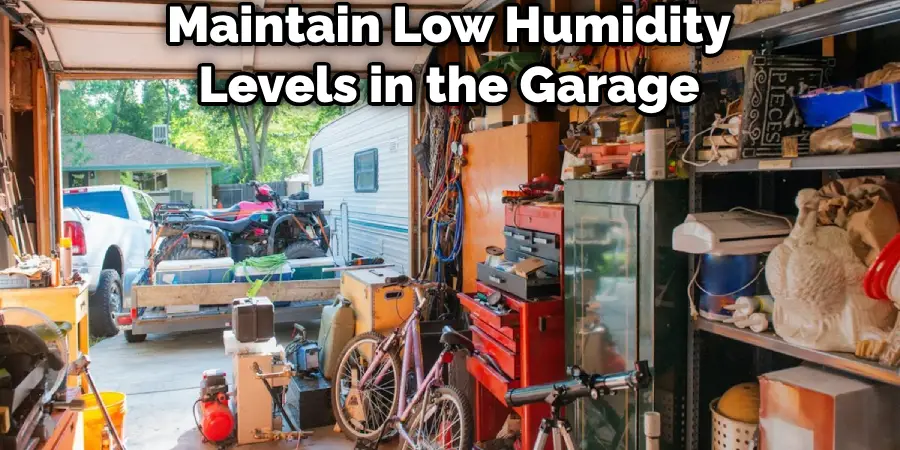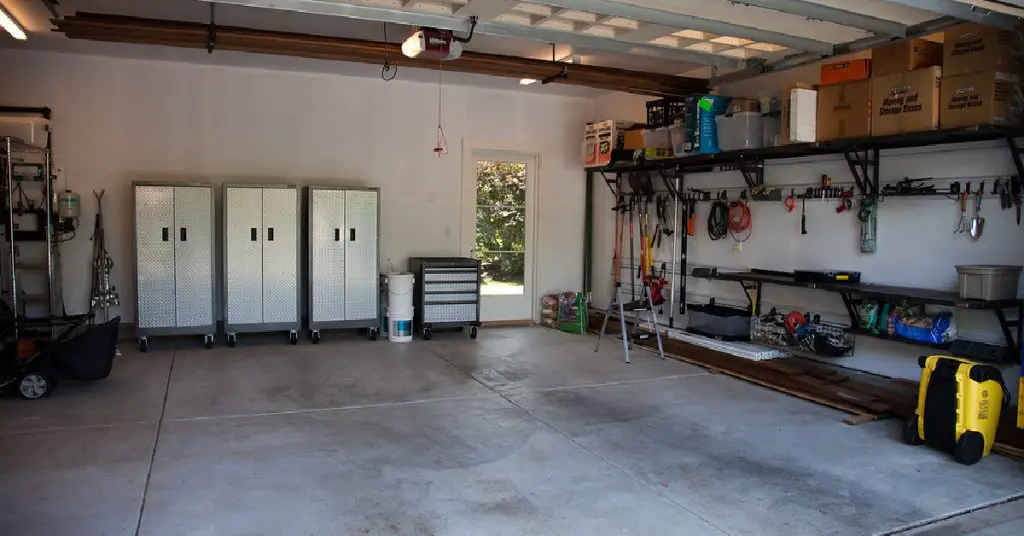If you have a large collection of books and not enough space in your home, you might be tempted to store some of them in your garage. But before you do that, you should know that storing books in a garage can be tricky and risky. Books are sensitive to humidity, temperature, pests, dust, and mold, and they can easily get damaged or ruined if they are not stored properly.

That’s why in this blog post, we will show you how to store books in a garage without damaging them. We will give you some steps and solutions for choosing the right location, containers, packing materials, arrangement, and maintenance for your books. By following these steps, you will be able to preserve and protect your books from harm and enjoy them for years to come.
Key Takeaways:
- Choose appropriate books for garage storage
- Use plastic bins or acid-free boxes, not cardboard
- Control humidity and temperature
- Elevate books off the floor
- Regularly inspect and maintain stored books
8 Effective Steps for How to Store Books in a Garage
Here are some steps you can follow to store books in a garage safely:
Step 1: Choose the Right Books to Store
Not all books are suitable for garage storage. You should avoid storing books that are rare, valuable, sentimental, or fragile in your garage, as they are more likely to get damaged or lost. Instead, store books that you don’t use often, such as reference books, textbooks, or duplicates. You can also store books that are easy to replace or cheap to buy.
Step 2: Choose the Right Location in the Garage
You should avoid storing your books near windows, doors, vents, pipes, or appliances that might cause leaks, drafts, or heat sources in your garage. You should also avoid storing your books directly on the floor or against the walls, as they can absorb moisture and dirt from these surfaces. Instead, you should store your books on shelves, racks, pallets, or cabinets that are elevated from the ground and away from the walls. You should also leave some space between your containers and the ceiling to allow air circulation and prevent condensation.
Step 3: Choose the Right Containers for the Books
Once you have found a suitable spot in the garage, you need to choose the right containers for the books. You should avoid using cardboard boxes, plastic bags, or newspapers, as they can trap moisture, attract insects, or transfer ink. These materials can damage the books and make them unreadable. Instead, you should use plastic bins, wooden crates, or acid-free archival boxes that are sturdy, waterproof, and breathable.

These containers will protect the books from water, dust, and pests, and allow some air to flow through them. You should also make sure that the containers are clean and dry before putting the books in them. You don’t want to introduce any dirt or moisture that could harm the books.
Step 4: Clean and Inspect Your Books
Before you pack your books for storage, you should clean them and check them for any signs of damage or infestation. You can use a soft cloth or a vacuum cleaner to remove any dust or dirt from your books. You should also look for any stains, tears, mold, mildew, or insect damage on your books and treat them accordingly. You can use a mild detergent or bleach solution to remove stains and mold from your books. You can also use insecticides or repellents to get rid of any bugs or rodents that might be living in your books.
Step 5: Choose the Right Packing Materials for the Books
After you have chosen the right containers for the books, you need to choose the right packing materials for the books. You should avoid wrapping the books in plastic wrap, tape, or bubble wrap, as they can damage the covers, pages, or bindings. These materials can stick to the books, tear them, or cause them to swell. Instead, you should use tissue paper, cotton cloth, or acid-free paper to wrap each book individually or in small groups.
These materials will cushion the books, prevent them from rubbing against each other, and keep them clean. You should also place some silica gel packets or baking soda inside the containers to absorb excess moisture and prevent mold growth. These substances will help keep the books dry and fresh.
Step 6: Choose the Right Arrangement for the Books
Now that you have wrapped the books and placed them in the containers, you need to choose the right arrangement for the books. You should avoid stacking the books too high or too tightly, as they can cause pressure, warping, or cracking. These conditions can deform the books and make them difficult to open or read. Instead, you should arrange the books horizontally or vertically with some space between them.

This will allow the books to maintain their shape and size, and make them easier to access. You should also place the heaviest books at the bottom and the lightest ones at the top. This will prevent the books from collapsing or crushing each other. You should also label each container with the contents and date of storage. This will help you keep track of what books you have and how long they have been in the garage.
Step 7: Label and Organize Your Containers
You should label each container with the name and category of the books inside it. This will help you find your books easily when you need them and avoid opening unnecessary containers that might expose your books to air and moisture. You should also organize your containers by size, weight, and genre. You should place heavier and larger containers at the bottom and lighter and smaller ones at the top. You should also group similar genres together and separate fiction from non-fiction.
Step 8: Monitor and Maintain Your Books Regularly
You should check on your books at least once every few months and inspect them for any signs of damage or deterioration. You should also clean and refresh your containers and materials periodically and replace them if they are worn out or damaged. You should also adjust the temperature and humidity levels in your garage if they are too high or too low for your books. Ideally, you should keep your garage at a constant temperature of around 65°F (18°C) and relative humidity of around 50%.

By following these steps, you can store your books in a garage safely and preserve them for a long time.
You Can Check It Out to Store Folding Tables in Garage
5 Alternative Storage Options for Books in the Garage
If you’re looking for alternative storage options for books in your garage, here are a few ideas to consider:
- Overhead garage storage racks: Utilize the overhead space in your garage by installing storage racks. These racks can be mounted on the ceiling and provide an excellent solution for storing books that are not frequently accessed. Make sure the racks are securely installed to prevent any accidents.
- Banker’s boxes: Banker’s boxes, made of sturdy board material, can be an affordable option for storing books in the garage. These boxes are available in various sizes to accommodate different book collections. Label the boxes for easy identification and maintain an organized system.
- Renting a storage space: If you have a large collection of books and limited garage space, you may consider renting a storage unit in your town. Look for indoor storage facilities that offer temperature and humidity control to protect your books from extreme conditions. Outdoor storage garages can be suitable for storing less valuable or paperback books.
- Wall-mounted book racks: Install wall-mounted book racks or floating shelves in your garage. These provide a space-saving option while keeping books off the floor. Make sure the racks are securely attached to the wall studs for stability and safety.
- Repurpose furniture: Consider repurposing furniture like bookcases, cabinets, or dressers to store your books in the garage. These pieces can provide both storage space and a decorative touch to your garage.
Remember to keep books away from direct heat sources, maintain a relatively cool temperature, and control humidity levels in the garage. Regularly inspect and clean your storage area to prevent dust accumulation and minimize the risk of pests.

By exploring these alternative storage options, you can find a suitable solution that fits your space, budget, and book collection while keeping your books well-organized and protected in the garage.
You Can Check It Out to Store a Mattress in a Garage.
8 Maintaining Tips for Low Humidity in the Garage
Humidity control is crucial for preserving the quality of books stored in the garage. Here are some tips to help you maintain low humidity levels:
- Use a dehumidifier: Invest in a dehumidifier specifically designed for garages. These devices help extract excess moisture from the air, reducing humidity levels. Place the dehumidifier in a central location for optimal efficiency.
- Ventilation: Improve air circulation in the garage by opening windows or installing vents. This allows fresh air to flow in and helps reduce humidity. Consider using fans or exhaust systems to promote airflow and minimize stagnant moisture.
- Seal cracks and gaps: Inspect the garage for any cracks, gaps, or openings where moisture can enter. Seal these areas with caulk or weatherstripping to prevent humid air from infiltrating the space.
- Avoid water sources: Keep water sources such as leaking pipes or faucets away from the garage. Fix any plumbing issues promptly to prevent moisture buildup.
- Moisture-absorbing materials: Place moisture-absorbing materials like silica gel packs or desiccant bags near the books or in strategic locations within the garage. These materials help absorb excess moisture and maintain a drier environment.
- Monitor humidity levels: Use a hygrometer to measure the humidity levels in the garage. Aim for a humidity range between 30% and 50%. Regularly check the readings and adjust your humidity control methods accordingly.
- Insulate the garage: Proper insulation helps regulate temperature and humidity levels in the garage. Insulate walls, doors, and windows to create a more controlled environment. Consider using insulation materials designed to resist moisture.
- Prevent condensation: Condensation can contribute to increased humidity levels. To prevent condensation, avoid storing wet or damp items in the garage, and ensure proper ventilation when performing activities that generate moisture, such as drying clothes or running a car engine.
By implementing these measures, you can effectively maintain low humidity levels in your garage, reducing the risk of mold, mildew, and moisture damage to your books. Creating a dry environment will help ensure the long-term preservation of your book collection.

FAQs About How to Store Books in a Garage
Is It Okay to Store Books in the Garage?
Yes, it is okay to store books in the garage. However, there are several things to consider before you place your books in the garage. Storing books in a garage involves picking the right containers, installing stable shelving, avoiding direct sunlight, controlling humidity levels, implementing a plan to keep pests away, and setting a reminder to check on your books once in a while.
Will Books Get Damp in a Garage?
Yes, books can get damp in a garage due to humidity and exposure to the outside air. Proper ventilation, dry conditions, and temperature control are essential for preserving books in a garage. Storing books in airtight containers or on bookshelves with care can help protect them. Avoid storing books in non-climate-controlled garages if possible.
What is the Best Way to Store Books?
The best way to store books is on a bookshelf in the main area of your house. Place the shelf near an interior wall for airflow and stable temperatures. If space is limited, use suitable containers. Avoid food near books to prevent pests. Keep book jackets on for protection. Dust books regularly and store them upright or flat.
Can Books Be Stored in High Heat?
No, books should not be stored in high heat. Heat can warp and damage the materials in books. Keep books away from direct heat sources and store them in a cool environment with temperatures between 60-75 degrees Fahrenheit for their preservation.
Conclusion
In conclusion, storing books in a garage can be a good solution for some people who have limited space, are moving, or want to declutter their homes. However, storing books in a garage can also be challenging and risky, as books are vulnerable to humidity, temperature, pests, dust, and mold. That’s why we have shared with you some steps and solutions for storing books in a garage without damaging them.
By following these steps and solutions, you will be able to choose the right location, containers, packing materials, arrangement, and maintenance for your books. You will also be able to preserve and protect your books from harm and enjoy them for years to come. We hope you found this blog post helpful and informative. If you have any questions or feedback, please feel free to leave a comment below. Thank you for reading!


